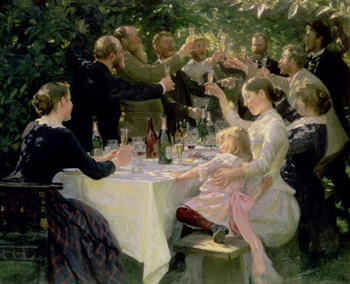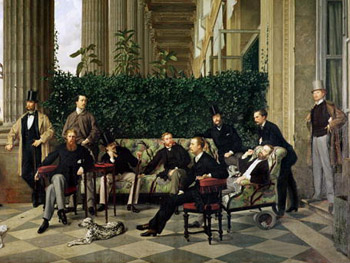Manners, Customs, Clothing
 |
 |
 |
 |
 |
 |
 |
The History of the Tie - III
Answering Objections to the Use of the Necktie
Some readers have raised objections to the use of the necktie as a symbol and uniform of the counter-revolutionary man, which I will address below with my own thoughts as well as comments made by eminent Catholic historian Dr. Plinio Correa de Oliveira.
Let women start to dress well, men will follow
One objection is the “passing of the buck” to women. Some men will say: “Well, what about the women? The women at Mass show up in vulgar and immodest clothing. Once women start dressing the way they should, then maybe men will too.”
 Not so. This disjointed kind of thinking inverts the order of the sexes. Since Paradise, men have been given a responsibility to lead women. After the fall, God gave Adam charge over Eve: “Thou shalt be under thy husband's power, and he shall have dominion over thee” (Gen 3:16). Subsequently, society was always led by men, with women following.
Not so. This disjointed kind of thinking inverts the order of the sexes. Since Paradise, men have been given a responsibility to lead women. After the fall, God gave Adam charge over Eve: “Thou shalt be under thy husband's power, and he shall have dominion over thee” (Gen 3:16). Subsequently, society was always led by men, with women following.
The same process happened with the institution of the Church: Christ is the head, and the Church is His Spouse. The Church follows Christ, not the other way around. St. Paul emphasizes this fact in his Letter to the Ephesians: “Therefore as the Church is subject to Christ, so also let the wives be subject to their husbands in all things” (Eph 5:24).
For men to point the finger at women to set the first example is, therefore, a lazy excuse to abandon their true responsibility. Such thinking inverts the natural order of the sexes that God Himself mandated since the beginning.
Giving women the responsibility to lead is to promote their masculinization, something that Dr. Plinio says is “purely and simply … a monstrous subversion of the natural order.” If men would dress as they should, women would quickly follow suit.
It does not make a difference
Another objection: “I would wear a tie, but what difference will it make? Everyone else will continue to wear casual clothing. One person wearing a tie won’t change anything.” To this I offer a rebuttal from Dr. Plinio’s Revolution and Counter-Revolution, who notes that the counter-revolutionary should not become discouraged because the great majority of men are not presently on his side. It is never the masses who made the Revolution, he points out, but rather small groups of revolutionary elites.
He continues: "The masses moved in a revolutionary direction because they had revolutionary elites behind them. If they had had elites of the opposite orientation behind them, they likely would have moved in the opposite direction.. For this formation, the counter-revolutionary can always use the resources of his individual action and can, therefore, obtain good results in spite of the shortage of material and technical means with which, at times, he may contend.” (pp. 86-87) [emphasis added]
Even with the "humblest of means," he notes, "counter-revolutionary action can obtain very appreciable results if such means are utilized with uprightness of spirit and intelligence. As we have seen, a counter-revolutionary action is conceivable even if reduced to mere individual activity. But it is inconceivable without individual action, which, if well accomplished, opens the way for every progress [emphasis added].” (pp. 88-89)
Without individual action, there is no Counter-Revolution. The counter-revolutionary man should find solace in this thought. Even when it seems that everyone else is dressed casually, he should remain firm in his resolve to fight the revolutionary tendencies in clothing.
To wear a necktie is vanity
Another objection from scrupulous traditionalist men: “I don’t want to wear a tie with a suit because it is just vanity; it is taking too much interest in my appearance and leads to pride.”
In response, I turn again to Dr. Plinio in his article “Dressing Well: Vanity or Virtue?”:
“The true answer is that in everything man does, an abuse can enter. One can abuse intelligence, courtesy, dressing well and even virtue, since a person can become proud of the virtue he practiced. This is not a reason to abandon civilized customs; rather they should be practiced with a vigilant eye turned toward curbing and controlling one’s vanity.
 "A civilized man presents himself as clean and decent with the dignity that his social condition requires. Doing this, he demonstrates the respect he has for himself and the respect he has for God, in whose presence he always is. Each one of us is worthy of respect, for we were created in the image and likeness of God, baptized in the Catholic Church, transformed into a temple of the Holy Spirit and chosen by Our Lady to serve her. Therefore, we must present ourselves in accordance with this dignity.”
"A civilized man presents himself as clean and decent with the dignity that his social condition requires. Doing this, he demonstrates the respect he has for himself and the respect he has for God, in whose presence he always is. Each one of us is worthy of respect, for we were created in the image and likeness of God, baptized in the Catholic Church, transformed into a temple of the Holy Spirit and chosen by Our Lady to serve her. Therefore, we must present ourselves in accordance with this dignity.”
Man can abuse any good thing; therefore, he can be vain when he dresses well. But this does not mean we should “throw the baby out with the bath water,” that is, to refuse to dress well because of the risk of vanity. We should strive to control our passions and bad tendencies and, at the same time, dress with dignity for the love of God, ourselves and our neighbor.
It is too uncomfortable to wear a necktie
Perhaps the most common objection: “I don’t wear neckties because they are too uncomfortable.” Since I am a woman, I have no experience wearing neckties, so I cannot venture an opinion based on experience on this matter.. What I can do, however, is rely on the opinions of men, who do have firsthand experience.
 A general internet investigation on the comfort of the necktie brings up the following issues: the size of the dress shirt, the fitting of the collar, and the tightness of the knot. Some men purport that if the dress shirt is too small, this may affect the fitting of the collar, which may end up being too tight and, thus, produce the feeling of being choked when a necktie is introduced. Additionally, if the knot is tied too tight around the neck, obviously this will inhibit one’s comfort as well.
A general internet investigation on the comfort of the necktie brings up the following issues: the size of the dress shirt, the fitting of the collar, and the tightness of the knot. Some men purport that if the dress shirt is too small, this may affect the fitting of the collar, which may end up being too tight and, thus, produce the feeling of being choked when a necktie is introduced. Additionally, if the knot is tied too tight around the neck, obviously this will inhibit one’s comfort as well.
The solution to this is simple, say some men: a well-fitting dress shirt (not too small) and collar along with a moderately tight knot should not inhibit any comfort.
Some other men I have talked to about this say that the opposite is true, that to not wear a necktie is uncomfortable. I leave this to the readers to discuss amongst their necktie-wearing friends.
My thoughts as an “outsider” on the matter: If neckwear has survived in Western society this long (since ancient Roman times, as mentioned here, surely it mustn’t be unreasonably uncomfortable. Otherwise, it would have been abandoned long ago. It is difficult to believe that it was maintained as an important item in men's' fashion because of a masochistic love for pain and discomfort. If anything, it should make things easier, adding dignity and at the same time protecting one’s neck from the elements (see part 1).
To wear a necktie is to despise the poor
Another objection: “I don’t want to wear a tie because it makes others think that I am superior to them. It goes against the principles of poverty and simplicity, so highly valued by Our Lord."
Simply put, this way of thinking is egalitarian, proletarian and miserablist. It reflects the blasphemous idea that we should despoil the Church, ridding it of all that is dignified, because “Christ loved the poor.”
 This progressivist notion was also addressed by Dr. Plinio, who likens this miserablist position to that of Judas:
This progressivist notion was also addressed by Dr. Plinio, who likens this miserablist position to that of Judas:
“When St. Mary Magdalene used a splendid perfume to wash the feet of Our Lord and dry them with her hair, the first seed of the splendor of the future worship of Jesus Christ was sown. When Judas revolted against that act, saying that the perfume was too expensive, should be sold and the money given to the poor, he also was planting a seed, the seed of the progressivist position, which hates the solemn and rich worship [emphasis added]. Notwithstanding, Our Lord argued against Judas, saying that the poor will always be with us, and He defended the position of Mary Magdalene.
“The position of the progressivists, therefore, is one that opposes temporal splendor for the Church. We call their ideal ‘miserablism’ or the ‘miserablist Church.’ According to this concept, the Church of Jesus is the church of the poor, a church made for the poor, and when she displays pomp and solemnity, she affronts the poor.
“It is egalitarianism in its most monstrous aspect – because it goes further than demanding equality between poor and wealthy men, but calls for equality between the poor and God, which is absurd, since God is infinitely greater and more than all men, including the wealthy ones. This, then, is the thinking of the progressivists, which is the same as that of Judas Iscariot.”
Analogously, in society there should be hierarchy between the classes, each one expressing its own dignity. One class should not sacrifice its own dignity in dress under the pretext that ceremonious clothing degrades the poor. The lower classes are always raised and elevated when they look to the elites and imitate them in their dignity of dress and manners. To say the opposite is to pay tribute to the fallacies of Communism and Miserablism.
The tie is revolutionary: it should be abandonned
 This objection is absurd, following the maxim: Abusus non tollit usum – The abuse of something does not prevent us from using it. We can use the same incoherent logic and apply it to shoes: Since shoes took on revolutionary aspects, we should stop wearing them. Or, since Satanists wore formal shirts, we shouldn’t wear them. Again, one cannot throw the baby out with the bathwater.
This objection is absurd, following the maxim: Abusus non tollit usum – The abuse of something does not prevent us from using it. We can use the same incoherent logic and apply it to shoes: Since shoes took on revolutionary aspects, we should stop wearing them. Or, since Satanists wore formal shirts, we shouldn’t wear them. Again, one cannot throw the baby out with the bathwater.
The fact is, the Revolution took the necktie, which was always a symbol of hierarchy and sacrality (see part 2 here), and turned it into the modern necktie in the late 19th century. Its symbolic aspect remained, albeit in an imperfect way. Since the Revolution is trying to eliminate the use of the modern necktie, we should continue its usage because it still has a symbolic meaning.
This is the reasonable and logical way to be a counter-revolutionary.
Continued

Posted October 18, 2017
Let women start to dress well, men will follow
One objection is the “passing of the buck” to women. Some men will say: “Well, what about the women? The women at Mass show up in vulgar and immodest clothing. Once women start dressing the way they should, then maybe men will too.”

When men are dressed well, even in leisure, the women follow suit
The same process happened with the institution of the Church: Christ is the head, and the Church is His Spouse. The Church follows Christ, not the other way around. St. Paul emphasizes this fact in his Letter to the Ephesians: “Therefore as the Church is subject to Christ, so also let the wives be subject to their husbands in all things” (Eph 5:24).
For men to point the finger at women to set the first example is, therefore, a lazy excuse to abandon their true responsibility. Such thinking inverts the natural order of the sexes that God Himself mandated since the beginning.
Giving women the responsibility to lead is to promote their masculinization, something that Dr. Plinio says is “purely and simply … a monstrous subversion of the natural order.” If men would dress as they should, women would quickly follow suit.
It does not make a difference
Another objection: “I would wear a tie, but what difference will it make? Everyone else will continue to wear casual clothing. One person wearing a tie won’t change anything.” To this I offer a rebuttal from Dr. Plinio’s Revolution and Counter-Revolution, who notes that the counter-revolutionary should not become discouraged because the great majority of men are not presently on his side. It is never the masses who made the Revolution, he points out, but rather small groups of revolutionary elites.
He continues: "The masses moved in a revolutionary direction because they had revolutionary elites behind them. If they had had elites of the opposite orientation behind them, they likely would have moved in the opposite direction.. For this formation, the counter-revolutionary can always use the resources of his individual action and can, therefore, obtain good results in spite of the shortage of material and technical means with which, at times, he may contend.” (pp. 86-87) [emphasis added]
Even with the "humblest of means," he notes, "counter-revolutionary action can obtain very appreciable results if such means are utilized with uprightness of spirit and intelligence. As we have seen, a counter-revolutionary action is conceivable even if reduced to mere individual activity. But it is inconceivable without individual action, which, if well accomplished, opens the way for every progress [emphasis added].” (pp. 88-89)
Without individual action, there is no Counter-Revolution. The counter-revolutionary man should find solace in this thought. Even when it seems that everyone else is dressed casually, he should remain firm in his resolve to fight the revolutionary tendencies in clothing.
To wear a necktie is vanity
Another objection from scrupulous traditionalist men: “I don’t want to wear a tie with a suit because it is just vanity; it is taking too much interest in my appearance and leads to pride.”
In response, I turn again to Dr. Plinio in his article “Dressing Well: Vanity or Virtue?”:
“The true answer is that in everything man does, an abuse can enter. One can abuse intelligence, courtesy, dressing well and even virtue, since a person can become proud of the virtue he practiced. This is not a reason to abandon civilized customs; rather they should be practiced with a vigilant eye turned toward curbing and controlling one’s vanity.

Well-dressed men expressing their dignity of state
Man can abuse any good thing; therefore, he can be vain when he dresses well. But this does not mean we should “throw the baby out with the bath water,” that is, to refuse to dress well because of the risk of vanity. We should strive to control our passions and bad tendencies and, at the same time, dress with dignity for the love of God, ourselves and our neighbor.
It is too uncomfortable to wear a necktie
Perhaps the most common objection: “I don’t wear neckties because they are too uncomfortable.” Since I am a woman, I have no experience wearing neckties, so I cannot venture an opinion based on experience on this matter.. What I can do, however, is rely on the opinions of men, who do have firsthand experience.

Marquis Boniface de Castellane (1837-1932) appears quite comfortable while wearing his necktie
The solution to this is simple, say some men: a well-fitting dress shirt (not too small) and collar along with a moderately tight knot should not inhibit any comfort.
Some other men I have talked to about this say that the opposite is true, that to not wear a necktie is uncomfortable. I leave this to the readers to discuss amongst their necktie-wearing friends.
My thoughts as an “outsider” on the matter: If neckwear has survived in Western society this long (since ancient Roman times, as mentioned here, surely it mustn’t be unreasonably uncomfortable. Otherwise, it would have been abandoned long ago. It is difficult to believe that it was maintained as an important item in men's' fashion because of a masochistic love for pain and discomfort. If anything, it should make things easier, adding dignity and at the same time protecting one’s neck from the elements (see part 1).
To wear a necktie is to despise the poor
Another objection: “I don’t want to wear a tie because it makes others think that I am superior to them. It goes against the principles of poverty and simplicity, so highly valued by Our Lord."
Simply put, this way of thinking is egalitarian, proletarian and miserablist. It reflects the blasphemous idea that we should despoil the Church, ridding it of all that is dignified, because “Christ loved the poor.”

A 1950s youth with a necktie reflects a seriousness sadly lacking today
“When St. Mary Magdalene used a splendid perfume to wash the feet of Our Lord and dry them with her hair, the first seed of the splendor of the future worship of Jesus Christ was sown. When Judas revolted against that act, saying that the perfume was too expensive, should be sold and the money given to the poor, he also was planting a seed, the seed of the progressivist position, which hates the solemn and rich worship [emphasis added]. Notwithstanding, Our Lord argued against Judas, saying that the poor will always be with us, and He defended the position of Mary Magdalene.
“The position of the progressivists, therefore, is one that opposes temporal splendor for the Church. We call their ideal ‘miserablism’ or the ‘miserablist Church.’ According to this concept, the Church of Jesus is the church of the poor, a church made for the poor, and when she displays pomp and solemnity, she affronts the poor.
“It is egalitarianism in its most monstrous aspect – because it goes further than demanding equality between poor and wealthy men, but calls for equality between the poor and God, which is absurd, since God is infinitely greater and more than all men, including the wealthy ones. This, then, is the thinking of the progressivists, which is the same as that of Judas Iscariot.”
Analogously, in society there should be hierarchy between the classes, each one expressing its own dignity. One class should not sacrifice its own dignity in dress under the pretext that ceremonious clothing degrades the poor. The lower classes are always raised and elevated when they look to the elites and imitate them in their dignity of dress and manners. To say the opposite is to pay tribute to the fallacies of Communism and Miserablism.
The tie is revolutionary: it should be abandonned

The necktie should not be abandoned because it was used by revolutionaries - above, Robespierre, the leader of the Terror in the French Revolution
The fact is, the Revolution took the necktie, which was always a symbol of hierarchy and sacrality (see part 2 here), and turned it into the modern necktie in the late 19th century. Its symbolic aspect remained, albeit in an imperfect way. Since the Revolution is trying to eliminate the use of the modern necktie, we should continue its usage because it still has a symbolic meaning.
This is the reasonable and logical way to be a counter-revolutionary.

Posted October 18, 2017
______________________
______________________








